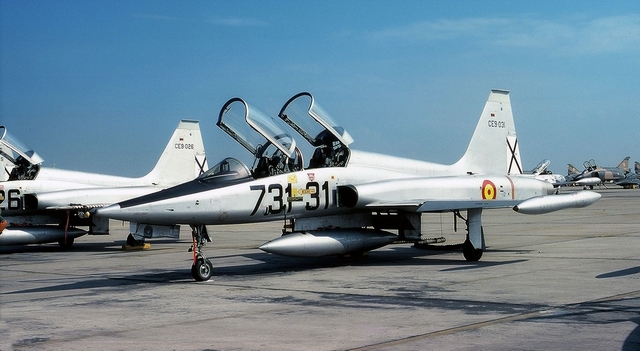The four candidates of the Spanish Air Force to replace its old F-5M
This week there has been news about a pending matter of the Spanish Air Force regarding new aircraft purchases.
Some planes that began to arrive in Spain in 1970
This issue has to do with the 19 Northrop F-5M Freedom Fighters operated by the 23rd Wing, based in Talavera La Real (Badajoz), and which are used for hunting and attack training. These aircraft were acquired by the Air Force in 1964 and the first arrived in Spain in January 1970, being then called SF-5B and replacing the Lockheed T-33 Shooting Star. The F-5M have already undergone two modernization processes, one in 1990 and another in 2008, and the third is already underway, which it was commissioned in 2023 from the Israeli company IAI to try to extend its operational life until 2030.

The frustrated Airbus AFJT project
Plans for the replacement of the F-5M have been changing for years. Until three years ago there was talk of the Airbus AFJT, a project presented by that European aeronautical company in 2020 and with which Spain could have replaced its F-5Ms and part of its fleet of C-101 Aviojet training aircraft. The Air Force showed interest in the project, but the lack of funds for its development by the Spanish government has left the AFJT in nothing.

Plans to replace the F-5M are experiencing delays
In March of last year, the Spanish Ministry of Defense stated that it was working on choosing a replacement for the F-5M: "the Government's commitment is which will be completed at the end of 2023Consequently, in 2024 we will already have the issue mature to be able to guarantee that in 2028 the new aircraft will be in the country for the training of our fighter and attack pilots." However, we are already about to end May 2024 and a replacement has not yet been chosen.
A Lieutenant Colonel of the Spanish Air Force points out four possible candidates
This Tuesday, May 21, Aviation Week Network published a news item stating: "Spain Revives F-5 Trainer Replacement". The news states the following: "Spain is looking at four systems already on the market for the F-5 replacement, while also studying the possibility of pursuing a brand new design, Lt. Col. Hugo Garcia Galán, deputy operational chairman for the Next Generation Weapon System effort at the Spanish Air and Space Force, told a Royal Aeronautical Society event here May 21."
The disadvantages of starting with a new design
The news notes that the development of a new fighter "would involve partnering with at least one other European country. Garcia said France, Italy or the UK would be among potential candidates." At this point, taking into account the delays that European aeronautical projects usually have, it is very unlikely that an aircraft whose development begins now could be operational in 2030. As if this weren't already very disconcerting, Aviation Week Network adds that "there is no firm timeline when a decision on the way forward will be made." That is, that in March of last year we were told that the decision would be made before the end of 2023, and even now a calendar has not even been designed to make that decision.

An assessment of the indicated candidates
The aforementioned website does mention the possible candidates that the Air Force would be considering, according to Lieutenant Colonel García. Coincidentally, three of them coincide with the ones I noted here last year: the Boeing-Saab T-7 Red Hawk (a joint project of the US and Sweden), the KAI T-50 Golden Eagle (manufactured by South Korea) and the Leonardo M-346 Master (manufactured by Italy). The fourth candidate would also be the TAI Hürjet (made in Turkey), although other contenders could also enter this race.

About the T-7, the T-50 and the M-346 I already gave details here, in relation to their features and weapons. Personally, I think that the best of these four candidates are the M-346 and the T-50, due to their performance, their ability to transport weapons (a characteristic that the T-7 does not have, which is unarmed) and that these are already operational aircraft.
Although I admit that the M-346 is my favorite, the T-50 has some notable advantages, such as having a 20 mm cannon as standard, a much greater weapons loading capacity ( more than the F-5M and M-346 combined) and the ability to achieve greater speed. In addition, the T-50 has a light fighter version, the FA-50, which has been acquired by Poland to replace its MiG-29. The similarities between the T-50 and the FA-50 would open the door for Spain to the possible acquisition of a second fighter model when the EF-18M are withdrawn from service, if it is not purchased the F-35 (it seems like a taboo subject in the Spanish government).

At the moment, the T-7 Red Hawk has very good prospects (I already told you here about this plane) but it is still in development. The U.S. Air Force is considering the possibility of this trainer having the capacity to be armed. In that case, it would be a good option to replace the Spanish F-5M.

As for the Turkish candidate, the TAI Hürjet still made its first flight on April 25, 2023, so it is also in the development phase. Turkey wants this aircraft to replace its T-38 Talon and the NF-5A/B of the Turkish Stars aerobatic patrol. The Spanish government may be considering this option for commercial reasons: Turkey has built a sister aircraft carrier to the "Juan Carlos I" L-61 together with the Spanish shipyard Navantia, the TCG Anadolu L-400. However, has approved the construction of another aircraft carrier, the TCG Trakya, without counting on Spain. On the other hand, the support of the Recep Tayyip Erdogan regime for Hamas terrorists should encourage us to avoid depending on Turkey for defense.
---
Main photo: Ejército del Aire.
|
Don't miss the news and content that interest you. Receive the free daily newsletter in your email: |
- Most read
- The 'hole' without civil flights around Paris during the opening of the Olympic Games
- Stunning footage of the F-15QA Ababil in flight recorded from its cockpit
- The firearms used by the Pontifical Swiss Guard, the smallest army in the world
- The most distant deployment of the Spanish Air Force in Australia and New Zealand
- Eurofighter vs F-35: the opinions of professional pilots on these advanced fighters
- The first photo of an F-16 fighter with Ukrainian insignia and the details it has revealed
- This is the driver station of an M1 Abrams tank and the impressive start of its engine

 ES
ES







Opina sobre esta entrada: